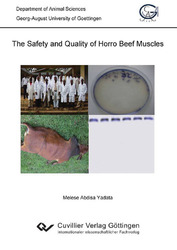| Departments | |
|---|---|
| Book Series (96) |
1378
|
| Nachhaltigkeit |
3
|
| Gesundheitswesen |
1
|
| Humanities |
2362
|
| Natural Sciences |
5406
|
| Mathematics | 229 |
| Informatics | 319 |
| Physics | 980 |
| Chemistry | 1363 |
| Geosciences | 131 |
| Human medicine | 243 |
| Stomatology | 10 |
| Veterinary medicine | 108 |
| Pharmacy | 147 |
| Biology | 835 |
| Biochemistry, molecular biology, gene technology | 121 |
| Biophysics | 25 |
| Domestic and nutritional science | 45 |
| Agricultural science | 1004 |
| Forest science | 201 |
| Horticultural science | 20 |
| Environmental research, ecology and landscape conservation | 148 |
| Engineering |
1790
|
| Common |
97
|
|
Leitlinien Unfallchirurgie
5. Auflage bestellen |
|
Advanced Search
The Safety and Quality of Horro Beef Muscles (English shop)
Melese Abdisa Yadata (Author)Preview
Table of Contents, Datei (54 KB)
Extract, Datei (62 KB)
Beef is the most favored food consumed either cooked and/or uncooked in Ethiopia. The sources of the beef consumed are animals slaughtered either formally in the city slaughter houses or informally otherwise. The slaughter beef stocks are either trekked or loaded to slaughter points from extensive or semi intensive management and production systems. Where formal slaughtering is practiced, an official veterinarian undertakes classical gross inspection. Approved carcasses are stamped and immediately loaded on a loading truck and sent away to butcheries for retailing. Obviously, such gross inspection is not strict way to assure safety of the carcass dispatched from the production line. Nevertheless, it is clear that beef animals can be reservoir of pathogens and carcasses can be good medium for spoilage and pathogenic organisms which impose risk of public health. On the other hand, neither level of safety nor epidemiological data following this supply and slaughter chain were documented as no health care and surveillance system adequate to produce such data were operating. Under such unreliable inspection systems and scanty data, spoilage of the beef and public health issues endangered by beef-borne hazards came to fore and were one of the major concerns of the investigators. The need of the country to improve safety and quality of carcasses not only for domestic consumption but also to comply with international beef export standards were as well taken into consideration.
| ISBN-13 (Printausgabe) | 386955150X |
| ISBN-13 (Hard Copy) | 9783869551500 |
| ISBN-13 (eBook) | 9783736931503 |
| Language | English |
| Page Number | 118 |
| Edition | 1 Aufl. |
| Volume | 0 |
| Publication Place | Göttingen |
| Place of Dissertation | Universität Göttingen |
| Publication Date | 2009-11-11 |
| General Categorization | Dissertation |
| Departments |
Biology
Agricultural science |








